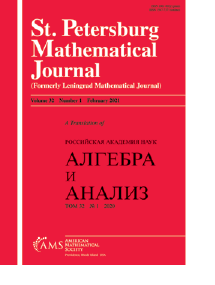The $\boldsymbol {\mathrm {BMO}}\boldsymbol {\to }\boldsymbol {\mathrm {BLO}}$ action of the maximal operator on $\boldsymbol \alpha$-trees
HTML articles powered by AMS MathViewer
- by
A. Osȩkowski, L. Slavin and V. Vasyunin
Translated by: V. Vasyunin - St. Petersburg Math. J. 31 (2020), 831-863
- DOI: https://doi.org/10.1090/spmj/1625
- Published electronically: September 3, 2020
- PDF | Request permission
Abstract:
The explicit upper Bellman function is found for the natural dyadic maximal operator acting from $\mathrm {BMO}(\mathbb {R}^n)$ into $\mathrm {BLO}(\mathbb {R}^n)$. As a consequence, it is shown that the $\mathrm {BMO}\to \mathrm {BLO}$ norm of the natural operator equals $1$ for all $n$, and so does the norm of the classical dyadic maximal operator. The main result is a partial consequence of a theorem for the so-called $\alpha$-trees, which generalize dyadic lattices. The Bellman function in this setting exhibits an interesting quasiperiodic structure depending on $\alpha$, but also allows a majorant independent of $\alpha$, hence a dimension-free norm constant. Also, the decay of the norm is described with respect to the growth of the difference between the average of a function on a cube and the infimum of its maximal function on that cube. An explicit norm-optimizing sequence is constructed.References
- Rodrigo Bañuelos and Adam Osȩkowski, Sharp weak type inequalities for fractional integral operators, Potential Anal. 47 (2017), no. 1, 103–121. MR 3666800, DOI 10.1007/s11118-016-9610-x
- Colin Bennett, Another characterization of BLO, Proc. Amer. Math. Soc. 85 (1982), no. 4, 552–556. MR 660603, DOI 10.1090/S0002-9939-1982-0660603-5
- Colin Bennett, Ronald A. DeVore, and Robert Sharpley, Weak-$L^{\infty }$ and BMO, Ann. of Math. (2) 113 (1981), no. 3, 601–611. MR 621018, DOI 10.2307/2006999
- R. R. Coifman and R. Rochberg, Another characterization of BMO, Proc. Amer. Math. Soc. 79 (1980), no. 2, 249–254. MR 565349, DOI 10.1090/S0002-9939-1980-0565349-8
- Paata Ivanisvili, Nikolay N. Osipov, Dmitriy M. Stolyarov, Vasily I. Vasyunin, and Pavel B. Zatitskiy, Bellman function for extremal problems in BMO, Trans. Amer. Math. Soc. 368 (2016), no. 5, 3415–3468. MR 3451882, DOI 10.1090/tran/6460
- Antonios D. Melas, The Bellman functions of dyadic-like maximal operators and related inequalities, Adv. Math. 192 (2005), no. 2, 310–340. MR 2128702, DOI 10.1016/j.aim.2004.04.013
- Antonios D. Melas, Sharp general local estimates for dyadic-like maximal operators and related Bellman functions, Adv. Math. 220 (2009), no. 2, 367–426. MR 2466420, DOI 10.1016/j.aim.2008.09.010
- Antonios D. Melas and Eleftherios Nikolidakis, Dyadic-like maximal operators on integrable functions and Bellman functions related to Kolmogorov’s inequality, Trans. Amer. Math. Soc. 362 (2010), no. 3, 1571–1597. MR 2563741, DOI 10.1090/S0002-9947-09-04872-7
- Antonios D. Melas, Eleftherios Nikolidakis, and Theodoros Stavropoulos, Sharp local lower $L^p$-bounds for dyadic-like maximal operators, Proc. Amer. Math. Soc. 141 (2013), no. 9, 3171–3181. MR 3068970, DOI 10.1090/S0002-9939-2013-11789-2
- F. L. Nazarov and S. R. Treĭl′, The hunt for a Bellman function: applications to estimates for singular integral operators and to other classical problems of harmonic analysis, Algebra i Analiz 8 (1996), no. 5, 32–162 (Russian, with Russian summary); English transl., St. Petersburg Math. J. 8 (1997), no. 5, 721–824. MR 1428988
- Adam Osȩkowski, Sharp inequalities for dyadic $A_1$ weights, Arch. Math. (Basel) 101 (2013), no. 2, 181–190. MR 3089774, DOI 10.1007/s00013-013-0537-9
- Adam Osȩkowski, Sharp weak type inequality for fractional integral operators associated with $d$-dimensional Walsh-Fourier series, Integral Equations Operator Theory 78 (2014), no. 4, 589–600. MR 3180879, DOI 10.1007/s00020-013-2116-7
- Winston Ou, The natural maximal operator on BMO, Proc. Amer. Math. Soc. 129 (2001), no. 10, 2919–2921. MR 1840094, DOI 10.1090/S0002-9939-01-05896-8
- Winston Ou, Near-symmetry in $A_\infty$ and refined Jones factorization, Proc. Amer. Math. Soc. 136 (2008), no. 9, 3239–3245. MR 2407089, DOI 10.1090/S0002-9939-08-09459-8
- Leonid Slavin and Vasily Vasyunin, Sharp $L^p$ estimates on BMO, Indiana Univ. Math. J. 61 (2012), no. 3, 1051–1110. MR 3071693, DOI 10.1512/iumj.2012.61.4651
- Leonid Slavin, Alexander Stokolos, and Vasily Vasyunin, Monge-Ampère equations and Bellman functions: the dyadic maximal operator, C. R. Math. Acad. Sci. Paris 346 (2008), no. 9-10, 585–588 (English, with English and French summaries). MR 2412802, DOI 10.1016/j.crma.2008.03.003
- Leonid Slavin and Vasily Vasyunin, Inequalities for BMO on $\alpha$-trees, Int. Math. Res. Not. IMRN 13 (2016), 4078–4102. MR 3544629, DOI 10.1093/imrn/rnv258
- V. Vasyunin, Cincinnati lectures on Bellman functions, ed. by Slavin L., 2011, https://arXiv:1508.07668.
Bibliographic Information
- A. Osȩkowski
- Affiliation: Faculty of Mathematics, Informatics and Mechanics, University of Warsaw, Banacha 2, 02-097 Warsaw, Poland
- ORCID: 0000-0002-8905-2418
- Email: ados@mimuw.edu.pl
- L. Slavin
- Affiliation: University of Cincinnati; St. Petersburg State University
- MR Author ID: 121075
- ORCID: 0000-0002-9502-8852
- Email: leonid.slavin@uc.edu
- V. Vasyunin
- Affiliation: St. Petersburg Department of the V. A. Steklov Mathematical Institute, RAS; St. Petersburg State University
- Email: vasyunin@pdmi.ras.ru
- Received by editor(s): November 12, 2018
- Published electronically: September 3, 2020
- Additional Notes: The second and third authors research was supported by the Russian Science Foundation grant 14-41-00010.
- © Copyright 2020 American Mathematical Society
- Journal: St. Petersburg Math. J. 31 (2020), 831-863
- MSC (2010): Primary 42A05, 42B35, 49K20
- DOI: https://doi.org/10.1090/spmj/1625
- MathSciNet review: 4022004


